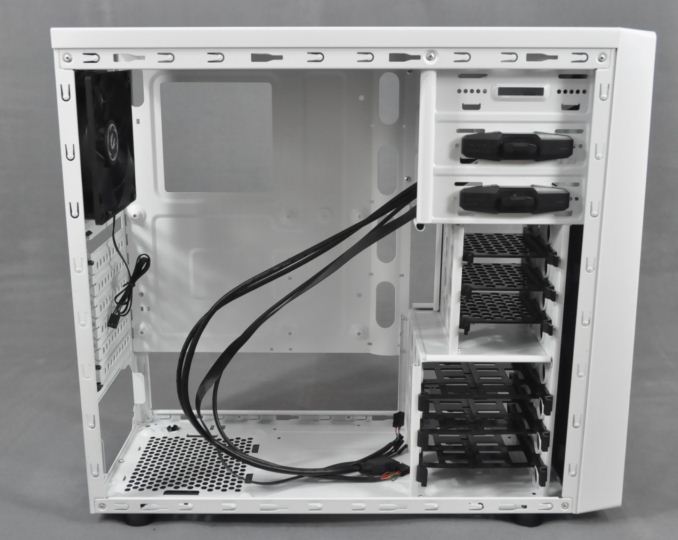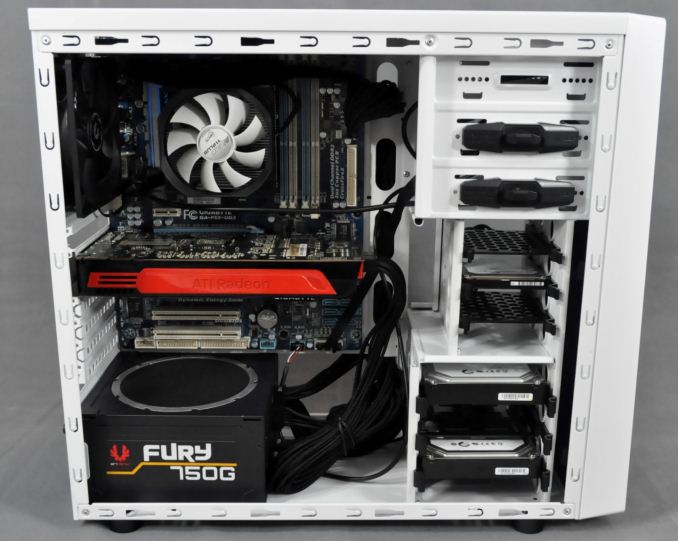BitFenix Neos Case Review
by E. Fylladitakis on January 21, 2015 9:00 AM EST- Posted in
- Cases/Cooling/PSUs
- bitfenix
- Case
BitFenix Neos Interior
The interior of the BitFenix Neos is relatively simple, nearly as much as a generic low cost Mid-Tower case. Everything inside the case is bolted together – no bays or metallic parts are removable. The motherboard tray is sizable enough for a typical ATX motherboard, with an opening behind the CPU area for the installation of CPU coolers.
Of course the size and location won't work for anyone with a motherboard that does not have its CPU socket right at the center of the upper left square area formed by the four screws, which will affect more than half of the motherboards available today, forcing the users to remove them in order to change the CPU cooler. On the other hand, those who rarely change out CPU coolers will be able to install the cooler before installing the motherboard. Note that the case is narrow as well, and CPU coolers taller than 150-155mm are not going to fit. Furthermore, instead of using brass motherboard stand-offs, the tray itself is embossed to form screw fixings for the motherboard. This can make assembly more convenient at times at the cost of some flexibility.
Across the right edge of the motherboard tray, there are four holes for the routing of cables. A fifth hole is present at the top left corner of the tray as well. None of these holes have any rubber grommets and all of them are barely large enough for an ATX 24-pin connector to fit. As there is virtually no clearance behind the motherboard tray for the routing of cables, the right section is elevated for the thick ATX cable to fit. Unfortunately, the use of a couple of PCI Express cables and SATA cables will require more than a little force to close the side panel.
There are three drive cages in the Neos. The top cage is for two 5.25" devices, which can be secured using the plastic locks. The middle cage is narrow, slightly increasing the clearance for one GPU card up to 310mm, and holds three trays for 2.5" devices. Finally, the bottom cage is for three 3.5" devices, but its trays can be used for 2.5" devices as well. For 3.5" devices, no tools are required, but in either case a screwdriver is necessary for the installation of a 2.5" drive.
The motherboard expansion slots are perhaps the greatest issue of the Neos. We have not seen the use of perforated non-reusable covers in a long time, but here they are, the removal of which is permanent and frequently leaves nasty dents behind. Above the expansion slots, the only stock fan of the case can be seen, a black 120mm fan. Take note that due to the narrowness of the case, there is no clearance to install a liquid cooling radiator wider than the fan itself here.
There is plenty of room for any kind of power supply, yet we advise against the installation of a unit longer than 160mm, as the fan opening is small and the displacement of the fan backwards will result in partial blockage, which is a problem with PSUs as it can leave critical components without sufficient cooling. The PSU sits on embossed metallic feet formed from the case panel itself. For this review, BitFenix supplied us one of their Fury 750G PSUs that has individually sleeved cables and is a perfect fit for the Neos.
As exhibited in the pictures of our test build, the interior of the BitFenix Neos is relatively comfortable to work with but can easily end up looking messy, as the cable management options are very limited. The only pathway for the routing of cables, to the right of the motherboard tray, becomes congested with just the thick 24-pin ATX cable going through it. The placement of the hole at the top left corner of the tray appears to have been done with little thought, as a typical motherboard blocks it entirely, leaving no room for a CPU power cable to fit through. There is enough space to comfortably work with the connectors and cables of the 2.5" and 3.5" drives though.
To summarize the component limitations once again, CPU coolers taller than 150mm are not recommended and a single 310mm GPU card may be installed. 160mm long PSUs are strongly advised. The radiators of AIO liquid cooling systems cannot be installed anywhere as well, and the routing options for cables are lacking. Given the price, these flaws could be overlooked provided the performance and other features prove desirable, so let's move on to our testing.


















54 Comments
View All Comments
GzeroD - Wednesday, January 21, 2015 - link
Any chance we could get some comparisons using some fans installed in the front 120mm fan slots?I wouldn't expect anyone to be putting 850W worth of components into a case like this without utilizing more of the fan mounting options.
E.Fyll - Thursday, January 22, 2015 - link
I wouldn't expect anyone to be putting 850W worth of components into this case. At all...We always test cases with their stock cooling options only. There is a virtually limitless number of possible cooling configurations for every single case out there, it is not possible to showcase them all. For instance, you requested the installation of two 120mm fans - which fans? 550 RPM silent fans or 5200 RPM Delta "jet engines"?
CosmonautDave - Thursday, January 22, 2015 - link
For what it's worth, the windowed version of the case comes with an additional front fan. So it would be "stock" if you had got that version. Maybe for the sake of comparison you could try this version with a 120mm front fan?vred - Wednesday, January 21, 2015 - link
"flashback to the 90s for those of us that are old enough"Great. Now I feel old. :D
Doomtomb - Wednesday, January 21, 2015 - link
Here's the deal with Bitfenix, they released the Prodigy in 2012 and took the mini-ITX PC crowd by storm. And then we have this.... they truly are a one-hit wonderStrangerGuy - Thursday, January 22, 2015 - link
You mean they made a mITX case that is almost as large or even larger than mATX cases. Case aesthetics are subjective that much I will admit, but I never understood their appeal from a pure functionality point of view because the entire point of the mITX is to f***ing save space.Antronman - Thursday, January 22, 2015 - link
Yeah I have to agree.And it's such a cramped case as well, despite being so large. If you fit a decent heatsink or a radiator, you can't have a DVD drive anymore. It's got 2 fan mount locations. I see so much wasted space.
StrangerGuy - Thursday, January 22, 2015 - link
Bitfenix Prodigy mITX = 24.9cm x 40.4cm x 35.9cm = 36.1LAerocool Dead Silence mATX cube = 26.5cm x 38.1cm x 41.1cm = 41.5L (only 14% larger)
Coolermaster N200 mATX tower = 37.8cm x 44.5cm x 20.1cm = 33.8L (Prodigy is LARGER by 7% despite being mITX only!)
I bet tons of a Prodigy just went "Oooooo mITX here" without doing the math for dimensions relative to form factor.
piasabird - Wednesday, January 21, 2015 - link
The metal mesh seems to have too small of holes. Probably makes the fans ineffective.ImSpartacus - Wednesday, January 21, 2015 - link
How long have the graphs used that gradient style?It looks like something an 8th grader would produce while they are still learning all of the features of Excel.
I don't know what visualization package you guys use, but you can do better. Sometimes less is more. This is Anandtech, not just some site.